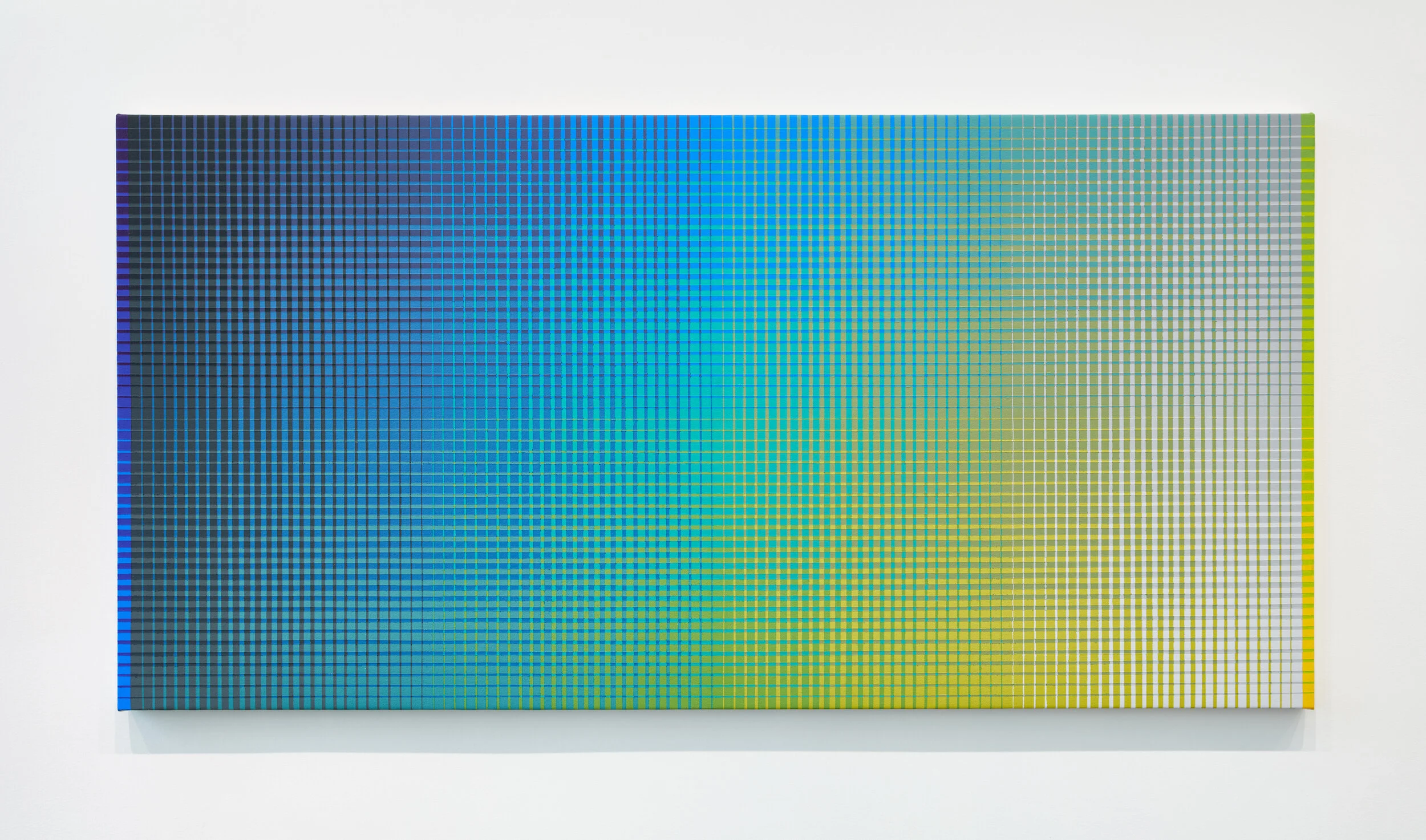Sanford Wurmfeld
b. 1942 Bronx, NY / Lives in New York, NY
Interested in Sanford Wurmfeld? Contact us.
Sanford Wurmfeld, I-18 + B/2 (Dk-BG-Lt), 2018, Acrylic on canvas, 42 x 85 inches / 107 x 216 cm, #SW46
Sanford Wurmfeld, II-18 + B/2 (Lt-RO-Dk), 2018, Acrylic on canvas, 42 x 85 inches / 107 x 216 cm, #SW47
Sanford Wurmfeld, II-25 + B/2 (BG-N-RO), 2018, Acrylic on canvas, 90 x 47 3/8 inches / 229 x 121 cm, #SW48
Sanford Wurmfeld, II-12 (LN-BG/N-B) + B/1(O), 2018, Acrylic on canvas, 30 x 31 inches / 76 x 79 cm, #SW50
Sanford Wurmfeld, II-12 (DN-BG/N-G) + B/1(R), 2018, Acrylic on canvas, 30 x 31 inches / 76 x 79 cm, #SW51
Sanford Wurmfeld, II-12 (LN-RO/N-R) + B/1(G), 2018, Acrylic on canvas, 30 x 31 inches / 76 x 79 cm, #SW52
Sanford Wurmfeld, II-12 (N-BG/N-BG) + B/1(RO), 2018, Acrylic on canvas, 30 x 31 inches / 76 x 79 cm, #SW53
Sanford Wurmfeld, II-12 (N-RO/N-RO) + B/1(BG), 2018, Acrylic on canvas, 30 x 31 inches / 76 x 79 cm, #SW54
Sanford Wurmfeld, II-25 + B/2 (BG-N-RO), 2018, Acrylic on canvas, 42 x 23 inches / 107 x 59 cm, #SW57
Sanford Wurmfeld, II-12 B/2 (RO), 2017-2019, Acrylic on canvas, 30 x 32 inches / 76 x 82 cm, #SW56
Sanford Wurmfeld, II-12 B/2 (BG), 2017-2019, Acrylic on canvas, 30 x 32 inches / 76 x 82 cm, #SW55
Biography
Sanford Wurmfeld (b. 1942 in Bronx, NY) has exhibited his work worldwide in solo and group exhibitions since the late 1960s. In 2013, he was the subject of a major 45-year survey exhibition entitled Sanford Wurmfeld: Color Visions, 1966-2013 curated by William C. Agee at Hunter College/Times Square Gallery, NYC. He has also presented solo exhibitions at Neuberger Museum of Art, Tibor de Nagy Gallery, Galerie Denise Rene, Susan Caldwell Gallery, Bard College, Maxwell Davidson Gallery (all New York), Karl Ernst Osthaus-Museum (Hagen, Germany), Mucsarnok Kunsthalle (Budapest, Hungary), Talbot-Rice Gallery (Edinburgh, Scotland), and Ewing Museum Gallery (Knoxville, TN).
In 1968, Wurmfeld was the youngest artist included in the landmark exhibition Art of the Real curated by Eugene Goossen at the Museum of Modern Art, NY. The exhibition traveled for the next two years to the Grand Palais (Paris, France), Kunsthaus (Zurich, Switzerland), and The Tate Gallery (London, England). Wurmfeld’s other museum group exhibitions include the American Academy of Arts and Letters, National Academy Museum (both New York), Visual Arts Center of New Jersey (Summit, NJ), Dayton Art Museum (Dayton, OH), Long Beach Museum of Art (Long Beach, CA), Karl Ernst Osthaus-Museum (Hagen, Germany), and Espace de l’Art Concret (Mouans-Sartoux, France), among others.
Here at the gallery, Wurmfeld mounted the well-received solo exhibition Light & Dark in 2013 and presented new paintings in the two-person exhibition Polychromy alongside Gabriele Evertz in 2017. His work was also highlighted in our group exhibitions On Paper in 2016 and Pointing a Telescope at the Sun in 2011, among other projects.
Complementing his studio practice, Wurmfeld has lectured and written extensively on the history of color, painting, and abstraction. He has received awards from the John Simon Guggenheim Memorial Foundation, National Endowment for the Arts, City University of New York, and Dartmouth College. Wurmfeld’s work is included in collections worldwide, including the Solomon R. Guggenheim Museum, Metropolitan Museum of Art, Brooklyn Museum (all New York), Karl Ernst Osthaus-Museum, Sprengler Museum (both Germany), and Espace de l’Art Concret (France), among others.
In addition to his artistic work, Wurmfeld taught in the Department of Art at Hunter College from 1967-2012, where he educated and mentored countless generations of artists. Originally invited to join the faculty by sculptor Tony Smith and critic Eugene Goossen, Wurmfeld was Chairman of the department from 1978-2006.
Overview
For more than five decades, Sanford Wurmfeld has exhaustively investigated the subject of color and its capacity to elicit wide-ranging emotional responses in the viewer. He has produced work across a broad array of media during his career, including painting, works on paper, sculpture, installation, and filmmaking.
Wurmfeld’s more recent work presents his ongoing inquiry into color’s three essential qualities: hue (a single, pure color), value (lightness or darkness of a color), and saturation (relative purity or intensity of a color). Using Arthur Pope’s color system as a point of departure – Pope was an early 20th Century color theorist and fine arts instructor at Harvard University – Wurmfeld organizes his new paintings around a 12-part color circle. which includes each of the 12 colors at full saturation, 10 of those same colors at half saturation (with the exception of yellow and violet), and 7 grays. Wurmfeld then places selections of those 29 colors onto layered grids of shifting alignment, which are often bookended by narrow bands of contrasting colors.
Wurmfeld recognizes color perception to be a highly subjective experience and he openly embraces differing, individualized responses on the part of the viewer. He writes, “For the last hundred years, some artist’s intentional selection of color in painting has been crucial to formulating expression. Such use of particular color choices by the discerning artist, creating through experiences of assimilation and contrast, give rise to various pictorial structures of pattern, space, duration, film, and luminosity. When the active, searching viewer has such emergent experiences, even though these experiences are ambiguous and shifting, the expressive feeling of the work is communicated.”
Gallery Exhibitions & Events
Twenty, June 24 - September 30, 2023
Untitled (Summer), July 19 - August 24, 2019
Sanford Wurmfeld: Variations, March 2 – April 20, 2019
Gabriele Evertz & Sanford Wurmfeld: Polychromy, July 8 – August 12, 2017
On Paper, July 9 – August 13, 2016
Sanford Wurmfeld: Light & Dark, March 29 – May 4, 2013
Epitaphs: Reception, Reading & Book Signing with Sanford Wurmfeld & Gerald Jonas, May 4, 2012
Pointing a Telescope at the Sun, August 6 – September 17, 2011
Sanford Wurmfeld: Cyclorama, Part 1, 2019
Sanford Wurmfeld: Cyclorama, Part 2, 2019
Sanford Wurmfeld: Cyclorama, Part 3, 2019
Sanford Wurmfeld: Cyclorama, Part 4, 2019
Sanford Wurmfeld: Cyclorama, Part 5, 2019
Sanford Wurmfeld, School of Art Lecture Series, University of Tennessee, 2011
Catalogs
Color Function Painting: The Art of Josef Albers, Julian Stanczak and Richard Anuszkiewicz, 1996
Color Seminar, by Sanford Wurmfeld, Published by MINUS SPACE, 2019
Epitaphs: Poems by Gerald Jonas, Paintings by Sanford Wurmfeld, 2012
Radiant Energy: Gabriele Evertz, Robert Swain, Sanford Wurmfeld, 2018
Sanford Wurmfeld: Color Visions 1966-2013, 2013
Sanford Wurmfeld: E-Cyclorama, 2008
Sanford Wurmfeld: Cyclorama (Amazon)
Vincent Longo: Prints 1954-1995, A Selection, by Sanford Wurmfeld, 1995 (Amazon)











